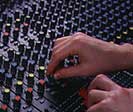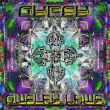| Author
|
spectrum analysis
|
PsyGZ
Started Topics :
5
Posts :
38
Posted : Jan 12, 2010 21:44:53
|
|
Do you use one to map out your frequencies? Any tips on how to use this in the most effective way? I saw an example once of metallica (enter sandman), where they were able to carve out pretty much one small area in the spectrum, so James could fit his vocals in there and not really muddy the rest of it.....It seems people like metallica (or their engineers) have this down to an absolute science. Any tips for trance? |

|
|
Freeflow
IsraTrance Full Member

Started Topics :
60
Posts :
3709
Posted : Jan 12, 2010 22:16
|
Its you who choose the sounds...
if you must have a sound that conflicts with certain parts you can either EQ the other parts to make room for the sound or you can EQ the sound to not conflict too much, often a blend of both is a good solution, but best is to choose sounds that has lesser conflicts.
if the conflict is that the kickdrum is too long and interfere with the attack of the baseline, they should interact but not interfere..
So you can try and fade out the kick, make it a little shorter, or pitchshift the tail so it fits better and dont create a frequency conflict.
Also, highpass certain sounds that really dont need subfreqs or at least Eq them out in the lowend.
Notches can be great for making room... as long as they dont take away too much character.
The best thing really is to choose the right sounds, sounds that fight for the same space are best to be kept separate... but too much separation will cause just that, too much separation and thats not good aswell
I think you can find lots of info here on isratrance, try the search and also go through some topics/threads.
|

|
|
jizy
IsraTrance Full Member

Started Topics :
90
Posts :
1493
Posted : Jan 13, 2010 02:33
|
|
Gliss
|

|
|
ohshit
IsraTrance Junior Member

Started Topics :
45
Posts :
605
Posted : Jan 13, 2010 10:25
|
Quote:
|
On 2010-01-12 22:16, Freeflow wrote:
Also, highpass certain sounds that really dont need subfreqs or at least Eq them out in the lowend.
Notches can be great for making room... as long as they dont take away too much character.
|
|
+1
to distribute sounds try to visualize the mix:
X - left and right: pan
Y - up and down: pitch
Z - near or far: volume
        http://soundcloud.com/alphadelphi http://soundcloud.com/alphadelphi |

|
|
Freeflow
IsraTrance Full Member

Started Topics :
60
Posts :
3709
Posted : Jan 13, 2010 12:57
|
ohshit - i listen to your tracks, "Virtual Analog" and "Nature Futura" i really like them 
very nice melodies, sweet bass.. Great music
cheers
|

|
|
bukboy
Hyperboreans

Started Topics :
40
Posts :
803
Posted : Jan 13, 2010 13:25
|
PsyGZ - the challenge in mixing a host of instruments together, is to retain their individual nuances and clarity. (although it can be a "sound" or genre to simply mash up the instruments into noise)
This is difficult to achieve with multiple similar sounds as the human ear relies heavily on the intrinsic frequencies of an instrument to perceive it with clarity.
What happens when you mix two similar frequency range different volume sounds, is that their frequencies are so close to each other that more powerful component frequencies from either sound mask the more subtle ones from the competing instrument in their vicinity, and what you have is the foreground instrument being clear(er) while others in its frequency range are not.
If you have TWO same volume similar frequency range foreground sounds, then they mask each other and mush up indistinctly.
So the astute engineer has to play a balancing game, simulating density, by alternating foreground instruments consequently.
Spectral analysis is a tool that gives you a visual feedback of the foreground instruments, to give you an indication of whether they can fit together, or if not, then what components (frequencies) of those instruments you would have to sacrifice for clarity if you have to have them play together.
You can go by ear of-course, but spectral analysis offers a very convenient and powerful tool for precise info gathering about your instruments.
The application of this tool is case based, and there are no guaranteed values that will always work, because each song is different. (I hope  ) )
But once you know the purpose, its an easy matter to use it for this task.
Ciao |

|
|
gutter
Inactive User

Started Topics :
54
Posts :
3018
Posted : Jan 13, 2010 16:07
|
^^ +1
And remember to listen with the ears and not with the eyes.
And mix according to your ears, not the analyzer visuals, its a trap you can easily fall , i would suggest not to use one, will make more mistakes looking at it while mixing
A spectrum analyzer cannot tell the nuance of a sound, your ears only can listen to it so your ears (and your spectrum analyzer brain) only can mix it imho 
|

|
|
ohshit
IsraTrance Junior Member

Started Topics :
45
Posts :
605
Posted : Jan 13, 2010 19:16
|
imho spectrum analyzer feedback is so much important as remember the relationship between notes and freqs, both are good starting points, but then you can go in almost any direction...
        http://soundcloud.com/alphadelphi http://soundcloud.com/alphadelphi |

|
|
ohshit
IsraTrance Junior Member

Started Topics :
45
Posts :
605
Posted : Jan 13, 2010 19:55
|
|
Uedi
IsraTrance Junior Member

Started Topics :
10
Posts :
288
Posted : Jan 13, 2010 23:07
|
Notice that Metallica and those kind of bands usually have a full-time highly qualified engineer on the studio! 
They do miracles! And improve music quality a lot.
That doesn't happen on trance!
I think it's always good to use a spectrum analizer!
Although, with continuous mixing practise you know where the elements belong. And that a certain type of sound correponds to a certain type of curve.
There's the volume leveling too...
I've analised various tracks and made printouts of their spectrums.
I also analise individual stems on several remix contest packs! eheh 
This map is on my wall!
http://img62.yfrog.com/img62/6531/fmclubmixdsktp.jpg
 |

|
|
GyPsynate
GyPsy

Started Topics :
29
Posts :
687
Posted : Jan 14, 2010 00:09
|
The only time I realy use one is when I'm about 80% done with a track to see where my freqs are peaking and to make sure I'm not missing a huge space.
Train your ears, not your eyes.
        \\\"Invoking the inner dancing buddha with future frequencies from beyond\\\" ~GyPsy \\\"Invoking the inner dancing buddha with future frequencies from beyond\\\" ~GyPsy
D-A-R-K Rec, Anomalistic Rec.
Cerebral Theater
http://www.molecular.cc/GyPsy/ |

|
|
PsyGZ
Started Topics :
5
Posts :
38
Posted : Jan 14, 2010 00:55
|
Quote:
|
On 2010-01-13 23:07, Uedi wrote:
Notice that Metallica and those kind of bands usually have a full-time highly qualified engineer on the studio! 
They do miracles! And improve music quality a lot.
That doesn't happen on trance!
I think it's always good to use a spectrum analizer!
Although, with continuous mixing practise you know where the elements belong. And that a certain type of sound correponds to a certain type of curve.
There's the volume leveling too...
I've analised various tracks and made printouts of their spectrums.
I also analise individual stems on several remix contest packs! eheh 
This map is on my wall!
http://img62.yfrog.com/img62/6531/fmclubmixdsktp.jpg

|
|
But why cant that happen in trance? Making use of the spectrum, and being able to place stuff in the proper spaces on the spectrum can only be a good thing....
Now ultimately, it must sound good too, but why not strive for great production..those engineers are only highly qualified because they learned the art of engineering from its base to its current state.....
I mean it all goes back to sound though...
but that's why metallica sounds so great....they have an enormous ability to pay attention to detail.
Art is one side of the brain..technical is the other side....
if you produce, you should be able to bring the two together, right? |

|
|
PsyGZ
Started Topics :
5
Posts :
38
Posted : Jan 14, 2010 00:57
|
Thanks everyone for your feedback....
I feel now that its best to use a combination of the two, but ultimately it may look good and sound like crap....or could sound good but look like crap...
It goes down to what sounds good in the end as the most important factor..
Analysis should simply be a tool |

|
|
Speakafreaka
IsraTrance Junior Member

Started Topics :
18
Posts :
779
Posted : Jan 14, 2010 02:52
|
It may look good and sound like crap ... but the opposite is rarely true IMO.
Spectrum analyzers are what I would define as the fastest way to really getting to grips with precision EQ and controlling a mix(note that doesn't mean fast). I recommend both Voxengo Gliss and Fab Filter Pro-Q as all in one solutions (analyzer is better with Vox, EQ better with Fab Filter).
The best pure, out and out analyzer VST is the (free) Voxengo Span, thanks to Slope control, Block size, Speed, and Avg tools. A formidable piece of software that has taught me a frightening amount about mixing!
        . .
http://www.soundcloud.com/speakafreaka |

|
|
PsyGZ
Started Topics :
5
Posts :
38
Posted : Jan 14, 2010 23:01
|
|
Thanks, that is the general consensus I am gathering...I tried in my slow drive track that I posted yesterday on the workshop section (please have a listen and let me know what you think. I would appreciate it).....I noticed most of the energy is in the low end of the spectrum...I don't think it sounds terrible, but I am still pretty new to this so maybe that is my perception. |

|
|